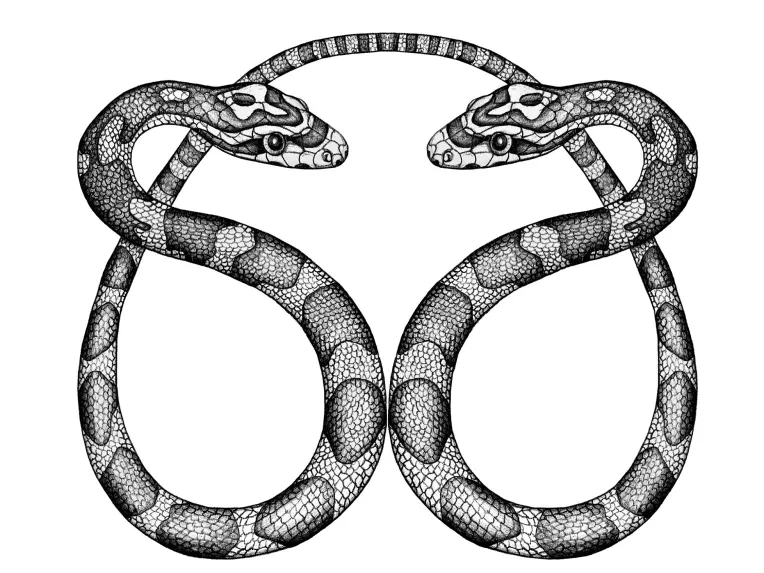The Enduring Fascination with Snake Symbolism
Snakes. They evoke a primal fear and fascination, slithering their way into our myths, religions, and dreams for centuries. These enigmatic creatures have captivated human imagination, becoming powerful symbols with a diverse range of meanings across cultures and throughout history. Let’s delve into the captivating world of snake symbolism and unravel the secrets behind their enduring presence in our collective consciousness.
Fear and Reverence: The Two Sides of Snake Symbolism
Snakes embody a profound duality. While their venomous bites and sudden movements inspire fear, their grace, and ability to shed skin evoke awe and wonder. This duality is at the heart of snake symbolism, making them complex and multifaceted figures in our cultural narratives.
Transformation and Renewal: Shedding More Than Just Skin
The snake’s ability to shed its skin is perhaps its most recognized symbolic characteristic. This process of shedding the old to reveal the new has linked snakes to themes of rebirth, transformation, and leaving the past behind.
This symbolism is deeply rooted in our history. In ancient Greek mythology, Asclepius, the god of healing, carried the Rod of Asclepius – a staff with a snake wrapped around it. This symbol endures as a representation of medicine, reminding us of the snake’s association with healing and renewal.
Healing and Venom: A Surprising Connection
The connection between snakes and healing might initially seem paradoxical, given the danger associated with their venom. However, this potent substance, while potentially lethal, is also used to create antivenom and develop life-saving medications. This use of venom in medicine adds another layer to the snake’s symbolic connection to healing, demonstrating that even something harmful can possess life-saving potential.
A Tapestry of Meanings: Snake Symbolism Across Cultures
One of the most captivating aspects of snake symbolism is its variability across cultures, reflecting diverse beliefs and interpretations. Here’s a glimpse into how different cultures view these enigmatic creatures:
| Culture | Snake Symbolism |
|---|---|
| Ancient Egypt | Divine beings, protectors of royalty, symbols of chaos and order |
| Hinduism | Wisdom, fertility, powerful deities like Naga |
| Native American Cultures | Rain, fertility, spiritual guides, connection to the earth |
| Aboriginal Australian Cultures | Ancestral spirits, creators of the land, links between the physical and spiritual worlds |
This table represents just a fraction of the diverse interpretations surrounding snakes. Each culture weaves its unique stories and beliefs, shaping how these creatures are understood and integrated into their worldview.
Snakes in Our Dreams: Messages from the Subconscious?
Snakes often slither into our dreams, leaving us with a sense of unease or intrigue. While dream interpretation is subjective, snakes, as powerful symbols, may represent something deeper within our subconscious.
Some experts suggest that snakes in dreams relate to themes of change, hidden fears, powerful emotions, or even personal growth. Like messengers from the depths of our minds, they urge us to pay attention to these aspects of ourselves and decipher their significance in our waking lives.
Snakes in the Modern World: From Fear to Respect
Even today, snakes maintain a firm grip on our collective imagination. They appear in art, literature, and popular culture, continuing to fascinate and frighten. However, there’s a growing appreciation for their role in the natural world.
We’re beginning to recognize snakes as essential parts of balanced ecosystems, deserving respect rather than fear. As we learn more about these creatures, we may uncover even deeper layers of meaning and appreciate their intricate connection to the web of life.
Unraveling the Mysteries: A Journey Without End
The symbolism of snakes is a rich tapestry woven from fear and awe, danger and healing, death and rebirth. Exploring this symbolism is an ongoing journey that takes us through history, culture, and the depths of our subconscious. As we continue to study and learn from these fascinating creatures, we may find ourselves unraveling new layers of meaning, enriching our understanding of both the natural world and ourselves.
Analyzing Snake Symbolism in the Bible for SEO Success
Beyond the Garden: Unraveling the Serpent’s Multifaceted Role in the Bible
While snakes are often viewed negatively, the serpent in the Bible is more than just a symbol of evil—it embodies a complex interplay of temptation, wisdom, and even divine healing. Understanding the serpent’s symbolism requires navigating its dual nature: a creature associated with both cunning deception and profound spiritual transformation.
The Serpent’s Duality
- Temptation and Deception:
- Genesis 3: The serpent tempts Eve with forbidden fruit, leading to the Fall of Man. This story establishes the serpent as a symbol of temptation, deceit, and disobedience, solidifying its negative association in Western culture.
- Revelation 12:9: The serpent is identified as Satan, further cementing its connection to evil.
- Wisdom and Cunning:
- Matthew 10:16: Jesus instructs his disciples to be “as shrewd as snakes,” acknowledging their intelligence and ability to navigate danger. This passage suggests that snakes can also represent positive qualities like wisdom and discernment when used strategically.
Transformation and Healing
- Shedding Skin: The snake’s physical transformation through shedding its skin aligns with the Christian concept of spiritual transformation, symbolizing rebirth, renewal, and leaving the old behind to embrace new life in Christ.
- The Bronze Serpent (Numbers 21:4-9): God instructs Moses to create a bronze serpent to heal Israelites bitten by venomous snakes. This event portrays the serpent as an instrument of divine healing, demonstrating its capacity for both harm and restoration.
The Serpent’s Enduring Significance
From the Garden of Eden to the bronze serpent of Moses, snakes in the Bible challenge us to confront our own capacity for both sin and redemption. The serpent’s enduring presence in biblical texts invites us to decode its symbolism and glean deeper spiritual insights into the human condition.
Slithering Towards Fortune: Is The Snake A True Symbol of Good Luck?
Snakes evoke a sense of mystery, often associated with fear and danger. However, in many cultures, snakes are revered as symbols of good luck, representing fortune, wisdom, and positive transformation.
Shedding Skin and Embracing New Beginnings
The snake’s ability to shed its skin is central to its positive symbolism. This process, universally representing rebirth and renewal, resonates with the idea of shedding old baggage and embracing new beginnings – a concept often linked to good luck and fortune.
Cultural Perspectives on Snakes and Good Fortune
While Western traditions, heavily influenced by the serpent in the Garden of Eden, often demonize snakes, many Eastern cultures celebrate them as auspicious signs. Here’s a glimpse into these contrasting viewpoints:
| Culture | View of Snakes |
|---|---|
| Western | Often negative, linked to temptation and sin |
| Eastern | Generally positive, symbolizing wisdom and rebirth |
Beyond Fear: Unveiling the Positive Symbolism
To truly understand the “good luck” symbolism of snakes, we need to look beyond the fear they often evoke. Snakes embody cycles, transformation, and the constant interplay of good and bad that shapes our lives. They remind us that change is inevitable and that even within perceived danger lies the potential for growth and renewal.
The Psychology of Snake Symbolism: Fear, Transformation, and Healing
Snakes occupy a unique space in the human psyche, simultaneously representing our deepest fears and our potential for growth and transformation. This duality is central to understanding what snakes symbolize in psychology.
Primal Fear and the Unconscious Mind
Ophidiophobia, the fear of snakes, is one of the most common phobias, suggesting a primal fear deeply rooted in our evolutionary history. This fear likely stems from our ancestors’ need to avoid venomous snakes to survive. In psychology, snakes often symbolize aspects of ourselves that we fear or repress, representing the untamed, instinctual aspects of our unconscious mind.
Transformation and the Shadow Self
Carl Jung, a prominent psychologist, viewed snakes as archetypes of the unconscious, representing the process of individuation—the journey of becoming a whole, integrated self. He believed that snakes symbolize the shedding of old identities and the emergence of the true self. This shedding process can be challenging, forcing us to confront our “shadow selves” – the parts of ourselves we deem unacceptable or fear to acknowledge.
Snakes in Dreams: Messages from Within
In dreams, snakes often represent unresolved conflicts, hidden desires, or repressed emotions surfacing into consciousness. While dream interpretation is subjective, a snake bite in a dream, for example, might symbolize the need to pay attention to a neglected area of life or confront a painful truth.
Beyond Good and Evil: Embracing the Duality
Snake symbolism in psychology defies simple categorization as purely good or bad. Just as snakes embody both venom and the potential for healing, our unconscious minds contain both destructive and creative forces. Recognizing and integrating these aspects of ourselves is crucial for personal growth and psychological well-being.
Snake Symbolism: Decoding Good & Bad Omens Across Cultures
Encountering a snake often evokes strong emotions, prompting many to wonder about its significance as an omen. However, determining whether a snake sighting signifies good or bad luck is rarely straightforward. The meaning is often nuanced, shaped by cultural beliefs, personal experiences, and the specific circumstances surrounding the encounter.
Cultural Interpretations: A Global Tapestry of Meanings
Across the globe, cultures have developed diverse interpretations of snake encounters. Here are a few examples:
- Ancient Egypt: The Uraeus, a stylized cobra, represented royalty, protection, and divine power, adorning the headdresses of pharaohs.
- Native American Traditions: Many tribes associate snakes with healing, transformation, fertility, and the earth’s energy.
- Eastern Cultures: In some Eastern traditions, snakes symbolize good fortune, wisdom, and guardianship.
Beyond ‘Good’ and ‘Bad’: Embracing the Complexity
Interpreting snake encounters as purely good or bad omens oversimplifies their rich symbolism. Factors like the snake’s color, the location of the encounter, and your personal feelings can influence its meaning:
- Color Symbolism:
- Black: Often associated with mystery, transformation, and the unknown, representing the potential for both positive and negative change.
- White: Commonly linked to purity, new beginnings, healing, and spiritual awakening.
- Red: Often connected to passion, danger, primal energy, and a call to pay attention to your instincts.
Ultimately, the meaning we ascribe to snake encounters reflects our personal beliefs and experiences.
Snakes as Powerful Messengers: A Call to Self-Reflection
Rather than simply labeling snake sightings as “good” or “bad” omens, perhaps it’s more beneficial to view them as opportunities for self-reflection. These encounters invite us to examine our fears, embrace the potential for transformation, and deepen our understanding of the interconnectedness of life. By approaching snake symbolism with curiosity and an open mind, we can glean valuable insights into ourselves and the world around us.
- Senior at What Age: Benefits & Eligibility Guide - March 29, 2025
- Unlocking Senior Benefits: How Old is a Senior? Your Complete Guide - March 29, 2025
- Master Russian Politeness:A Guide to Saying Please - March 29, 2025
















